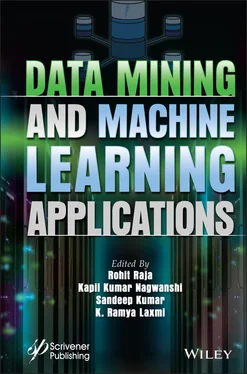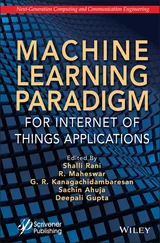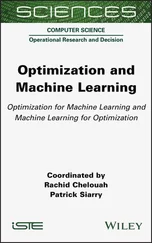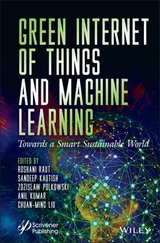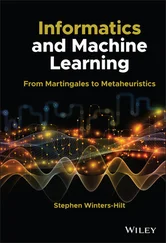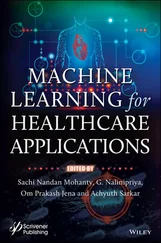Data Mining and Machine Learning Applications
Здесь есть возможность читать онлайн «Data Mining and Machine Learning Applications» — ознакомительный отрывок электронной книги совершенно бесплатно, а после прочтения отрывка купить полную версию. В некоторых случаях можно слушать аудио, скачать через торрент в формате fb2 и присутствует краткое содержание. Жанр: unrecognised, на английском языке. Описание произведения, (предисловие) а так же отзывы посетителей доступны на портале библиотеки ЛибКат.
- Название:Data Mining and Machine Learning Applications
- Автор:
- Жанр:
- Год:неизвестен
- ISBN:нет данных
- Рейтинг книги:3 / 5. Голосов: 1
-
Избранное:Добавить в избранное
- Отзывы:
-
Ваша оценка:
- 60
- 1
- 2
- 3
- 4
- 5
Data Mining and Machine Learning Applications: краткое содержание, описание и аннотация
Предлагаем к чтению аннотацию, описание, краткое содержание или предисловие (зависит от того, что написал сам автор книги «Data Mining and Machine Learning Applications»). Если вы не нашли необходимую информацию о книге — напишите в комментариях, мы постараемся отыскать её.
The book elaborates in detail on the current needs of data mining and machine learning and promotes mutual understanding among research in different disciplines, thus facilitating research development and collaboration.
Audience
Data Mining and Machine Learning Applications — читать онлайн ознакомительный отрывок
Ниже представлен текст книги, разбитый по страницам. Система сохранения места последней прочитанной страницы, позволяет с удобством читать онлайн бесплатно книгу «Data Mining and Machine Learning Applications», без необходимости каждый раз заново искать на чём Вы остановились. Поставьте закладку, и сможете в любой момент перейти на страницу, на которой закончили чтение.
Интервал:
Закладка:
5 Chapter 5Figure 5.1 Shows different data clustering stages.Figure 5.2 Shows clustering techniques classifications.Figure 5.3 Shows centroid linkage clustering.Figure 5.4 Show fuzzy clustering.Figure 5.5 Shows silhouette’s graphical representation of clusters. (a) Represen...Figure 5.6 Shows Output vectors of Algorithm.Figure 5.7 Shows realistic of the three Silhouettes with a various number of gro...Figure 5.8 Shows Silhouette estimation using K-Means Algorithm archives by the f...
6 Chapter 6Figure 6.1 Data mining implementation process.Figure 6.2 Shows flowchart of the research.Figure 6.3 Exactness classifier’s comparison.Figure 6.4 Datastream model.Figure 6.5 Model execution graph.
7 Chapter 7Figure 7.1 Process flow of incident and ticket.Figure 7.2 Process flow of incident and ticket.Figure 7.3 Service request effort estimation and incident resolution workflow.Figure 7.4 Ticket count vs. day of week based on priority of the tickets.Figure 7.5 Ticket count vs time of the day in which it is logged based on priori...Figure 7.6 Industry domain by ticket volume.Figure 7.7 Sample ticket format.Figure 7.8 Raw data collected from organization.Figure 7.9 Research methodology to develop effort prediction model.Figure 7.10 Effort values predicted vs. observed using training and test dataset...Figure 7.11 Effort values predicted vs. observed using training and test dataset...
8 Chapter 8Figure 8.1 Process life cycle.Figure 8.2 Confusion matrices.
9 Chapter 9Figure 9.1 Decision tree example.Figure 9.2 Shows the ID3 algorithm.Figure 9.3 Shows RULES flow chart.Figure 9.4 RULES-3 calculation.Figure 9.5 Procedure of RULE-3 plus rule forming.Figure 9.6 RULE-4 incremental induction procedure.Figure 9.7 Pseudocode portrayal of RULES-6.Figure 9.8 RULES3-EXT calculation.Figure 9.9 A disentangled depiction of RULES-7.Figure 9.10 REX-1 algorithm.Figure 9.11 Construction procedure of fuzzy decision tree.Figure 9.12 Offered multidimensional databases architecture from fuzzy data mini...
10 Chapter 10Figure 10.1 Shows different sources of big data.Figure 10.2 Show automated CPS cycle.Figure 10.3 Show clustering of big data.Figure 10.4 Shows CPS smart grid.Figure 10.5 Shows CPS military application.Figure 10.6 Shows CPS smart city application.Figure 10.7 Shows CPS environmental application.Figure 10.8 FlockStream Algorithm’s pseudo-code.Figure 10.9 (a) Synthetic information sets. (b) Clustering was performed by Floc...
11 Chapter 11Figure 11.1 Shows CRISP-DM methodology.Figure 11.2 Shows all six stages of the CRISP-DM model.Figure 11.3 Shows business understanding phase of CRISP-DM model.Figure 11.4 Shows data understanding phase of CRISP-DM model.Figure 11.5 Shows data preparation phase of CRISP-DM model.Figure 11.6 Shows modeling phase of CRISP-DM model.Figure 11.7 Shows evaluation phase of the CRISP-DM model.Figure 11.8 Shows deployment phase of CRISP-DM model.Figure 11.9 Shows coordination of various modules in ERP frameworks.Figure 11.10 Cash flow data mining CRISP-DM methodology.Figure 11.11 InfoCube loading in SAP BIW’s ETL mapping.Figure 11.12 DM modeling & visualization of SAP ADP.Figure 11.13 Shows overall influence chart of relative dominance in clustering m...Figure 11.14 Overall influence chart of clustering model.
12 Chapter 12Figure 12.1 Shows the CRISP and KDD process flowchart.Figure 12.2 Shows data mining process.Figure 12.3 Shows visual analytics flowchart.Figure 12.4 Shows visual analytics and human–interaction.Figure 12.5 HCI information mining approach with an accentuation on parts of ind...Figure 12.6 Reflections of basic inductive learning ideas thought about and rela...Figure 12.7 Shows human involvement in different data mining approaches.Figure 12.8 Flowchart of gesture recognition.Figure 12.9 Block diagram of Gesture Recognition framework.Figure 12.10 (a, b, c, d): Shows hand gestures.Figure 12.11 Zoom-in gesture recognized.Figure 12.12 Zoom-out gesture recognized.Figure 12.13 Towards right movement gesture recognized.
13 Chapter 13Figure 13.1 Different types of datasets: (a) standard (balanced), (b) unbalanced...Figure 13.2 Sample skin lesion images from public dataset (a) PH2, (b) ISIC2016,...Figure 13.3 Illustration of proposed framework.Figure 13.4 Representing decision boundary amid negative and positive instances ...Figure 13.5 Performance comparison analysis. (a) AUCROC respective to standard d...
14 Chapter 14Figure 14.1 Shows supervised learning algorithm.Figure 14.2 Shows unsupervised learning algorithm.Figure 14.3 Shows semi-supervised learning algorithm.Figure 14.4 Shows regression learning algorithm.Figure 14.5 Shows instance-bases learning algorithm.Figure 14.6 Shows regularization algorithm.Figure 14.7 Shows decision-tree algorithm.Figure 14.8 Shows bayesian algorithm.Figure 14.9 Shows clustering algorithm.Figure 14.10 Shows association rule learning algorithm.Figure 14.11 Shows artificial neural network algorithm.Figure 14.12 Shows deep learning algorithm.Figure 14.13 Shows dimensionality reduction algorithm.Figure 14.14 Shows ensemble algorithm.Figure 14.15 Information mining assignments and models.Figure 14.16 Descriptions of under-fit, standard, and over-fit versions.Figure 14.17a Shows supervised learning.Figure 14.17b Shows sigmoid function.Figure 14.18 Shows one-versus all or multi-class classification.Figure 14.19 Shows illustration of clustering process.Figure 14.20 The description of the learning phase.Figure 14.21 Harvard database result.Figure 14.22 Sub-part result of Iris setosa .Figure 14.23 Sub-part result of iris versicolour.Figure 14.24 Sub-part result of Iris virginica .
15 Chapter 15Figure 15.1 Represents the flow chart of proposed methodology using three layers...Figure 15.2 Flow diagram of PCA algorithm used in our proposed methodology.Figure 15.3 Simple architecture of 3-Layer RBM.Figure 15.4 Performance Metric Comparison (Accuracy) by using 80–20 as size rati...Figure 15.5 Performance Metric Comparison (Sensitivity) by using 80–20 as size r...Figure 15.6 Performance Metric Comparison (Specificity) by using 80–20 as size r...Figure 15.7 The seizure occurs during each hour for all the pediatric patients o...
16 Chapter 16Figure 16.1 Option of boundary space measurements for the Delhi database. (a) wi...Figure 16.2 Selection of boundary for worldwide calculation of the Delhi dataset...Figure 16.3 Shows heatmap.Figure 16.4 Example of transformation from a heatmap into a double guide utilizi...Figure 16.5 Binary anticipated guides utilizing various percentiles to character...Figure 16.6 Label forecast by characterized percentile edge.Figure 16.7 Model evaluation against different category levels. It is feasible t...Figure 16.8 Heatmaps assumptions using several edges. (a) uses the 96th percenti...Figure 16.9 Large-goal heatmap from over Delhi region. The rose-colored region o...Figure 16.10 Shows flow chart of proposed application system.Figure 16.11 Shows icon of application.Figure 16.12 Shows form of registration.Figure 16.13 Shows login page.Figure 16.14 Misconduct place finder.Figure 16.15 Location recognized on map.Figure 16.16 Show message sent by user.Figure 16.17 Shows received message to enrolled contact.Figure 16.18 Location of client.
17 Chapter 17Figure 17.1 Object instance segmentation.
List of Tables
1 Chapter 1 Table 1.1 Comparison in a data warehouse—OLTP.
2 Chapter 2 Table 2.1 Shows social media network applies to various data services.
3 Chapter 3 Table 3.1 Show the advantage and disadvantage of different types of RS. Table 3.2 Shows which technique, evaluation criteria are used in different RS. Table 3.3 Base of usage predication. Table 3.4 Comparative study of hybrid approach with traditional approach.
4 Chapter 5Table 5.1 The transformation from word to lexeme.Table 5.2 Transformation to an extraordinary word list.Table 5.3 Vector portrayal of a report corpus.Table 5.4 The portrayal of the corpus utilized in this examination.Table 5.5 Groups with various Silhouette an incentive for every calculation.
Читать дальшеИнтервал:
Закладка:
Похожие книги на «Data Mining and Machine Learning Applications»
Представляем Вашему вниманию похожие книги на «Data Mining and Machine Learning Applications» списком для выбора. Мы отобрали схожую по названию и смыслу литературу в надежде предоставить читателям больше вариантов отыскать новые, интересные, ещё непрочитанные произведения.
Обсуждение, отзывы о книге «Data Mining and Machine Learning Applications» и просто собственные мнения читателей. Оставьте ваши комментарии, напишите, что Вы думаете о произведении, его смысле или главных героях. Укажите что конкретно понравилось, а что нет, и почему Вы так считаете.
